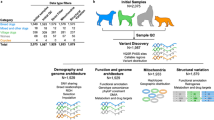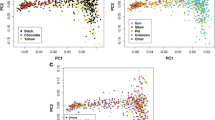Abstract.
Purebred dogs are a unique resource for dissecting the molecular basis of simple and complex genetic diseases and traits. As a result of strong selection for physical and behavioral characteristics among the 300 established breeds, modern dogs are characterized by high levels of interbreed variation, complemented by significant intrabreed homogeneity. A high-resolution map of the canine genome is necessary to exploit the mapping power of this unusual resource. We describe here the integration of an expanded canine radiation hybrid map, comprised of 600 markers, with the latest linkage map of 341 markers, to generate a map of 724 markers—the densest map of the canine genome described to date. Through the inclusion of 217 markers on both the linkage and RH maps, the 77 RH groups are reduced to 44 syntenic groups, thus providing comprehensive coverage of most of the canine genome.
Similar content being viewed by others
Author information
Authors and Affiliations
Additional information
Received: 10 June 1999 / Accepted: 23 September 1999
Rights and permissions
About this article
Cite this article
Mellersh, C., Hitte, C., Richman, M. et al. An integrated linkage-radiation hybrid map of the canine genome. 11, 120–130 (2000). https://doi.org/10.1007/s003350010024
Issue Date:
DOI: https://doi.org/10.1007/s003350010024




